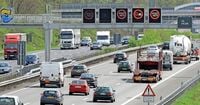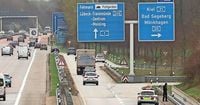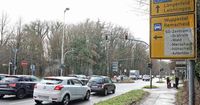Traffic congestion is a common issue across various regions in Germany, with significant delays reported in cities like Lübeck, Potsdam-Mittelmark, Remscheid, Solingen, and Wolfsburg. As of April 19, 2025, the latest traffic reports from multiple sources highlight the most congested routes and the reasons behind the slow-moving traffic.
In Lübeck, the LN-Staumelder provides an up-to-date overview of traffic conditions, revealing that the Autobahns A1, A20, and A226, along with Bundesstraßen B75, B207, and B104, are currently experiencing notable slowdowns. According to the ADAC, the A1 and A7 in Schleswig-Holstein are particularly prone to traffic jams, especially during peak tourist seasons. The A1, which connects Hamburg with coastal towns and runs through Stormarn, Lübeck, and Ostholstein, is often plagued by congestion during these busy times.
The data for Lübeck comes from TomTom, which utilizes GPS data from millions of devices, along with information from approximately 80 million mobile devices and numerous road sensors. This data is updated every five minutes, ensuring that residents and travelers receive timely alerts about changing traffic conditions. The collaboration with TomTom allows for accurate and reliable traffic updates, helping drivers plan their journeys more effectively.
Meanwhile, in Potsdam-Mittelmark, the MAZ-Staumelder reported similar issues. Key routes include the Autobahns A9 and A10, as well as Bundesstraßen B1 and B2, which are heavily trafficked. The area around the Ferch triangle is particularly notorious for accidents, with the A9 towards Beelitz also seeing a high number of incidents. The report emphasizes the importance of caution, particularly on the L79 near Nuthetal, where slippery conditions can lead to accidents. Like Lübeck, the traffic data in Potsdam-Mittelmark is sourced from TomTom, ensuring consistency and reliability in reporting.
In Remscheid, the RGA-Staumelder highlights the challenges faced on the A1 and A46, which are among the most congested routes in North Rhine-Westphalia (NRW). The A1 has seen nearly 6,500 hours of traffic jams between Cologne and Dortmund, making it a significant bottleneck for commuters. The A46, which connects Düsseldorf and Wuppertal, is also a critical route, ranking as the sixth most congested in NRW. The report notes that the B229 and B237 are essential for local traffic, connecting various towns and facilitating commutes.
Solingen, too, faces traffic challenges, with the ST-Staumelder reporting that the A1, A3, and A46 are among the top ten congestion routes in NRW. The A3 is particularly problematic, with commuters experiencing over 10,000 hours of delays in 2023. Ongoing construction work on the A3 near Solingen has exacerbated the situation, making travel in and out of the city even more challenging. The B229 and B224 serve as vital connections for residents, linking Solingen with surrounding areas.
Wolfsburg also faces its share of traffic issues, with the WAZ-Staumelder providing insights into the current situation. The A2 and A39 are major routes in the area, along with Bundesstraßen B188, B4, B248, and B244. As with the other regions, the data is sourced from TomTom, ensuring that drivers have access to updated information every five minutes. The emphasis on safety and consideration for other road users is a common theme across all regions, urging drivers to remain vigilant.
In summary, the traffic situation across these regions in Germany remains challenging, with various factors contributing to congestion. The reliance on reliable data sources like TomTom helps residents and travelers navigate these issues more effectively. As construction projects and accidents continue to impact traffic flow, staying informed is crucial for all road users.








